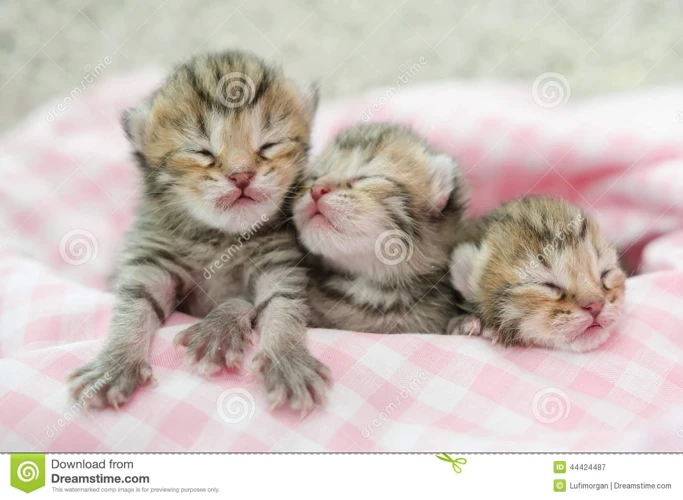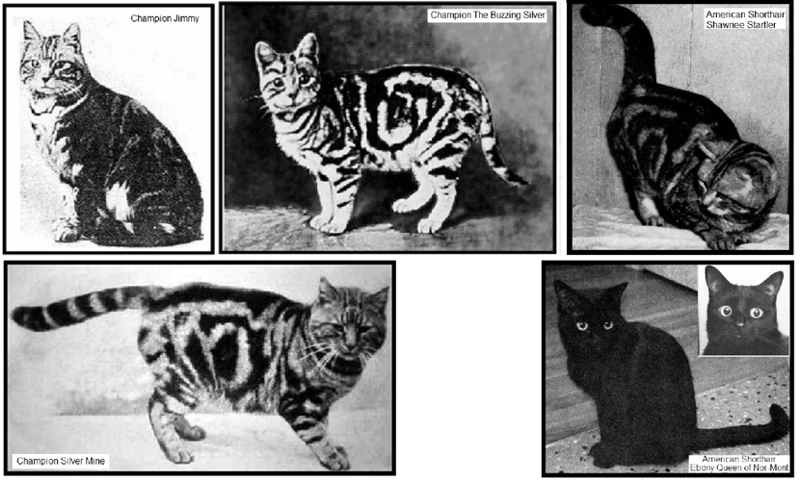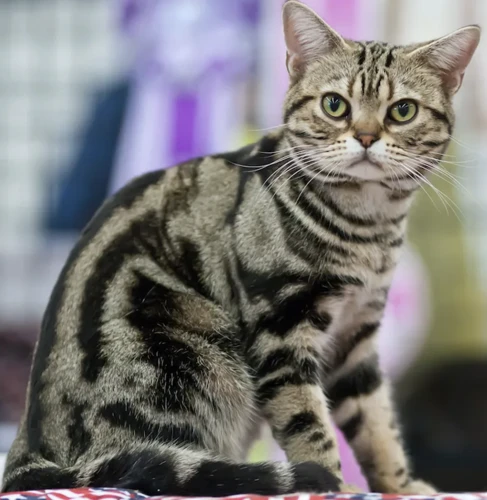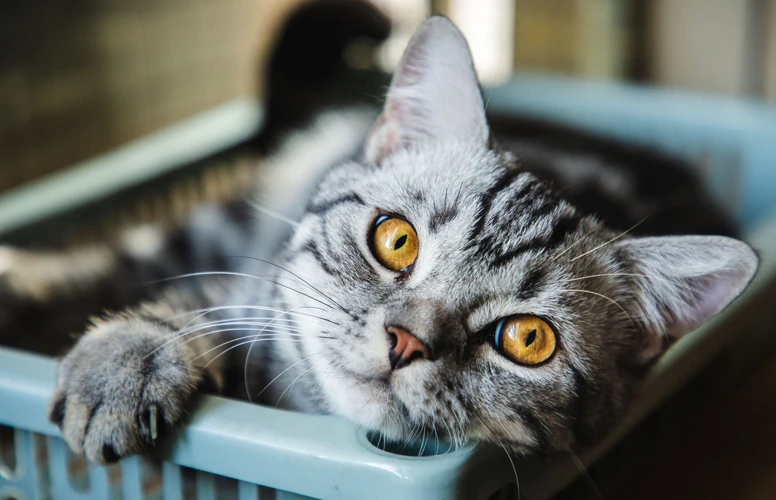Bringing home a new kitten is a thrilling and overwhelming experience. Every kitten, including the American Shorthair, experiences unique changes during their development stages. As a responsible pet owner, it’s essential to understand these stages and how to cater to your kitten’s behavioral needs. From birth to the first year of life, American Shorthair kittens go through tremendous growth and behavioral milestones. In this article, we’ll explore the physical and behavioral changes that American Shorthair kittens go through in each developmental stage. Additionally, we’ll provide tips on how to care for your kitten’s needs so they can grow into a healthy and happy adult cat. So, let’s dive into the fascinating journey of an American Shorthair kitten’s development!
Stage 1: Newborn – 3 Weeks

Welcoming a new American Shorthair kitten into your home is an exciting and rewarding experience. During the first few weeks, your kitten will be in the newborn to 3-week stage, a delicate time that is critical for their growth and development. It’s important to understand what is happening in this stage to provide your kitten with the support and care they need to thrive. In this section, we will explore the physical growth and behavioral milestones of this stage, so you can ensure that your kitten is on the right track. As your kitten grows, it’s essential to know how to cater to their behavioral needs. Let’s dive into stage one and understand how you can give your American Shorthair kitten the best start in life. To learn about American shorthairs climbing safety, click here.
Physical Growth and Development
The physical growth and development of an American Shorthair kitten can be divided into five stages. During these stages, kittens experience significant changes in size, weight, and physical abilities. Let’s break them down:
Newborn Stage (0-3 weeks): During the first few weeks of their lives, kittens are completely dependent on their mother for nutrition and cannot regulate their body temperature. At birth, kittens weigh between 2-4 ounces and gain approximately 0.5-1 ounce each day. They are born with their eyes and ears closed, and their senses develop gradually over the first few weeks.
Second Stage (3-7 weeks): During this stage, kittens triple their birth weight and their eyes and ears begin to open. They start to stand and walk, and their baby teeth begin to appear. Kittens are still dependent on their mother, but may begin to sample solid food.
Third Stage (7-12 weeks): During this stage, kittens continue to gain weight and their adult teeth begin to come in. They become more active, playful, and curious, and start displaying their unique personality traits. Kittens should remain with their mother and littermates until they are at least 8 weeks old for proper socialization.
Fourth Stage (3-6 months): During this stage, kittens experience a growth spurt and may gain up to 2 pounds per month. They become more coordinated and agile, and their hunting instincts develop. Kittens may become more independent, but still require proper training and socialization to avoid developing negative behaviors.
Fifth Stage (6-12 months): During this stage, kittens reach their full adult size and weight and their personalities become more set. They may continue to display high energy levels and require plenty of physical and mental stimulation.
As your American Shorthair kitten develops, monitor their weight and growth to ensure they’re healthy and consult with a veterinarian if you have any concerns.
To learn more about your American Shorthair kitten’s physical growth and development, consider checking our article on litter preferences or understanding body language. It’s crucial to provide proper care and attention to your kitten to ensure they grow into happy and healthy adult cats.
Behavioral Milestones
During the first three weeks of life, American Shorthair kittens are entirely dependent on their mother for survival. They are born with their eyes and ears closed and rely on their sense of smell to find their mother and their littermates. During this stage, kittens spend most of their time sleeping, eating, and cuddling with their siblings.
As they enter the second stage of development, between three and seven weeks of age, their eyes and ears begin to open. They become more active, crawling and exploring their environment. They also start to develop their senses of sight and hearing, which helps them understand their surroundings better. During this stage, kittens start to develop their playful personas and begin interacting with their littermates, playing with each other’s tails and wrestling.
Between seven and twelve weeks old, the kittens enter the third stage of development, becoming more independent and curious at the same time. The little kittens are now able to explore their immediate environment more confidently. This stage of development is critical in establishing good behavior and habits. They should be exposed to various stimuli to shape them into a well-rounded cat when they grow up. This phase of development is when socialization with humans should start, which can set the foundation for future social behaviors.
In the fourth stage of development, which starts from three to six months, American Shorthair kittens start to become more confident and independent while still engaging in littermate play as a means to learn and socialize. Their growth rate also starts to slow down. During this stage, you may notice an increase in their energy level, which can lead to destructive behavior if they lack exercises such as playing with toys.
The fifth stage, which starts between six and twelve months, marks their transition to adulthood. However, some American Shorthairs remain playful and kittenlike even as adults. It is crucial to keep providing your cat with a stimulating environment and playtime at this stage and provide them with healthy, age-appropriate food.
Regardless of the stage of development, American Shorthair kittens have unique personalities, which may affect their behavior. However, suppose there is any form of aggressive or territorial behavior. In that case, it should be addressed by implementing positive reinforcement techniques such as those found in the article “Positive Reinforcement for American Shorthairs.” These techniques help to create a strong bond with your kitten and eliminate any aggressive or territorial tendencies. If you plan to introduce your American Shorthair to other animals, check out “How to Introduce an American Shorthair to New Animals” for helpful tips. Another useful resource to consider rearing your cat optimally is the “Tips for Managing Your American Shorthair’s Stress.” Finally, to understand the gender-specific impact on American Shorthair’s behavior, we recommend reading “How the Gender of Your American Shorthair Impacts Its Behaviour?”
Stage 2: 3 – 7 Weeks

As your American Shorthair kitten grows, they will enter a new developmental stage between the ages of 3 to 7 weeks old. During this period, your kitten will reach many physical and behavioral milestones that will shape their life for years to come. It’s important to understand your kitten’s growth and behaviors during this time, so you can ensure they are receiving the best care. In this stage, your kitten will become more active and playful. They will also begin to show signs of independence and explore their surroundings more. As a result, it’s important to provide them with a safe and nurturing environment to encourage healthy development. Let’s take a closer look at the physical growth and behavioral milestones that occur during this stage.
Physical Growth and Development
During the first stage of development, newborn American Shorthair kittens are very delicate and require constant attention and care. As they grow and reach 3 weeks of age, there are some notable changes that occur in their physical growth and development.
Birth Weight: At birth, American Shorthair kittens typically weigh around 3-4 ounces.
Weight Gain: During this stage, kittens should be gaining weight steadily. By the time they reach 3 weeks old, they should be around double their birth weight.
Coordination and Movement: Around 2-3 weeks old, American Shorthair kittens will start to develop coordination and movement. They will begin to crawl and explore their environment.
Teeth: Kittens will start to develop their baby teeth during this stage, with the first incisors usually appearing at around 2-3 weeks of age.
Eye and Ear Development: During this time, kittens’ eyes and ears will begin to open, and they will start to develop their senses of sight and hearing.
Transition to Solid Food: At around 3-4 weeks old, kittens will start to wean from their mother’s milk and transition to solid food. This is an important stage in their development, as it sets the foundation for their future eating habits.
It is important to note that during this stage, the physical growth and development of American Shorthair kittens is heavily influenced by their environment, diet, and overall health. Providing a safe and nurturing environment, regular veterinary check-ups, and proper nutrition will help ensure that they grow and develop healthy.
Internal link: Territorial behavior is one aspect that can be affected by environmental factors, such as the size of the living space.
Behavioral Milestones
During the various developmental stages of American Shorthair kittens, they go through a variety of behavioral milestones. These milestones can signal important changes in their personality and behavior. As a responsible pet owner, you should be aware of these stages so you can effectively cater to the needs of your kitten.
Newborn – 3 Weeks:
- After birth, the kitten’s primary focus is nursing and sleeping.
- Their sense of smell and touch are well-developed, but their eyes remain shut.
- They may begin to crawl and make soft noises, but they are still unable to walk.
3 – 7 Weeks:
- Kittens begin to open their eyes and become more curious about their surroundings.
- They start to stand and walk, developing their motor skills.
- They become more vocal and interactive with their littermates and mother.
- They may start to play and exhibit more adventurous behaviors.
7 – 12 Weeks:
- Kittens become more independent and begin to explore their environment more often.
- They start to learn how to groom themselves and use a litter box.
- They become more social and interactive with humans and may seek attention and affection.
- They may also become more active and playful.
3 – 6 Months:
- Kittens may experience a surge of energy and become more active and playful.
- They may exhibit aggressive behavior, such as biting and scratching, as they learn how to properly interact with their environment.
- They start to develop adult teeth and may begin to eat solid food exclusively.
6 – 12 Months:
- Kittens become more independent and may start to lose interest in playing and interacting with their owners.
- They start to develop sexually and may exhibit signs of sexual behavior.
- They become more territorial and may start to mark their territory.
It’s vital to keep in mind that every kitten is different, and their behavioral milestones may vary slightly. If you detect any unusual behavior outside of these typical milestones, consult your veterinarian or animal behaviorist. It’s essential to be aware of the symptoms of aggressive behavior as American Shorthairs might exhibit this trait during any development stage. To learn more about aggressive behavior in American Shorthairs, click here.
Stage 3: 7 – 12 Weeks

As your American Shorthair kitten enters their third stage of development, they will continue to grow and change rapidly. At this point, they have already gone through the critical socialization period and are beginning to explore their surroundings with greater curiosity. During this phase, your kitten will experience further physical and behavioral milestones, which require careful attention and care on your part. Let’s take a closer look at what changes you can expect during this crucial phase of your kitten’s development.
Physical Growth and Development
During the various stages of development, American Shorthair kittens undergo a significant amount of physical changes. It is essential to keep in mind that every individual kitten grows and develops at their own pace, so it is crucial to keep an eye on their progress and consult a veterinarian if necessary. Here are the physical growth and development milestones for each stage:
- Stage 1: Newborn – 3 Weeks
- At birth, kittens weigh between 2 and 4 ounces.
- They are born with closed eyes and ears.
- During this stage, kittens depend solely on their mother’s milk for nutrition and will gain weight rapidly.
- By the end of week three, kittens will double their weight.
- Stage 2: 3 – 7 Weeks
- Kittens’ eyes and ears begin to open, and they start exploring their surroundings.
- Kittens will start drinking water and eating solid food, in addition to nursing from their mother.
- During this stage, kittens will continue to grow rapidly and gain weight steadily.
- By the end of week seven, kittens will weigh around 2 pounds.
- Stage 3: 7 – 12 Weeks
- Kittens’ baby teeth begin to come in, and they start to play and interact with littermates and humans.
- Kittens’ coordination and mobility improve, and they will start to climb and explore higher surfaces.
- During this stage, kittens will continue to gain weight but at a slower rate.
- By the end of week twelve, kittens will weigh around 3 to 4 pounds and be close to their adult size.
- Stage 4: 3 – 6 Months
- Kittens’ permanent teeth begin to come in.
- Kittens become more independent and may experience a growth spurt.
- During this stage, kittens will continue to gain weight but at a slower rate than before.
- By the end of six months, kittens will weigh around 5 to 6 pounds and reach their adult size.
- Stage 5: 6 – 12 Months
- Kittens reach their full adult size and weight.
- Kittens’ energy levels and activity levels may change as they mature.
- During this stage, it is crucial to maintain a healthy diet and provide plenty of physical and mental stimulation for the kitten.
It is important to note that these milestones are just general guidelines, and not all kittens will reach them at the same time. It is essential to monitor each kitten’s individual growth and development to ensure they are healthy and thriving.
Behavioral Milestones
American Shorthair kittens have several behavioral milestones that they should reach during their early development. These milestones help to ensure that they develop properly and grow into healthy, happy adult cats. Let’s take a look at what to expect during each stage:
| Behavioral Milestones: | The kitten’s eyes and ears are closed, and they are not yet able to walk or stand. They rely completely on their mother for warmth, nutrition, and care. During this stage, bonding with their mother and littermates is crucial. |
|---|
| Behavioral Milestones: | The kitten’s eyes and ears open, and they start to explore their environment. They begin to walk and play, and they may start to wean off their mother’s milk and eat solid food. This is an important stage for socialization, as the kitten learns to interact with their littermates and people. |
|---|
| Behavioral Milestones: | The kitten becomes more independent and adventurous, and they continue to play and explore. They may start to establish a dominance hierarchy among their littermates. This is a crucial stage for training, as the kitten learns the rules of the household and how to behave properly. |
|---|
| Behavioral Milestones: | The kitten becomes more physically active and may start to display adolescent behavior, such as testing their boundaries and challenging authority. This is a critical stage for discipline and positive reinforcement training. The kitten may also start to develop their hunting instincts, so it’s important to provide appropriate outlets for play. |
|---|
| Behavioral Milestones: | The kitten reaches sexual maturity and may start to display more aggressive behavior towards other cats or people. This is a crucial stage for neutering or spaying, which can help to reduce undesirable behavior. The kitten may also become more affectionate and develop a closer bond with their human family. |
|---|
Understanding your American Shorthair kitten’s behavioral milestones is an important part of raising a healthy, happy cat. By providing appropriate care and training during each stage, you can help your kitten develop into a well-adjusted adult cat.
Stage 4: 3 – 6 Months

As your American Shorthair kitten progresses into the fourth stage of development, they are entering an exciting period of growth and change. At this stage, your kitten is becoming more independent and adventurous as they continue to discover the world around them. This is also a critical stage for physical development and ensuring your kitten receives proper nutrition and care is essential for their overall health and well-being. Let’s take a closer look at what you can expect during this stage of your kitten’s journey.
Physical Growth and Development
During the first few weeks of an American Shorthair kitten’s life, their physical growth and development is rapid. Here is a breakdown of what happens during each stage:
| Stage | Physical Changes |
|---|---|
| Newborn – 3 Weeks | Doubles their birth weight, ears and eyes are closed, they crawl and knead on their mother for warmth and food |
| 3 – 7 Weeks | Teeth begin to emerge, they start walking and playing, explore their surroundings |
| 7 – 12 Weeks | Adult teeth start to form, they become more coordinated and agile, they become more independent from their mother |
| 3 – 6 Months | They reach half of their adult weight, their reproductive organs develop, they start to lose their baby teeth |
| 6 – 12 Months | They reach their full adult weight and size, their coat thickens and becomes glossy, they become sexually mature |
It is important to note that each kitten may develop at a slightly different pace, so it’s best to consult with a veterinarian to ensure that your kitten is on track.
During each stage of growth, provide your American Shorthair kitten with plenty of opportunities for exercise and play to support their physical development. Toys, scratching posts, and climbing structures are excellent ways to encourage your kitten to be active. And as they grow, consider gradually transitioning them to a balanced diet of kitten-specific food to ensure that they receive all the necessary nutrients to support their development.
Behavioral Milestones
During each of the five stages of development, American Shorthair kittens reach important behavioral milestones. These milestones help to gauge the kitten’s growth and development, and provide insight into their overall health. Here are the main behavioral milestones for each stage:
| Developmental Stage | Behavioral Milestones |
|---|---|
| Newborn – 3 weeks |
|
| 3 – 7 weeks |
|
| 7 – 12 weeks |
|
| 3 – 6 months |
|
| 6 – 12 months |
|
It’s important to note that not all kittens reach these milestones at the same time, so there is some variation when it comes to developmental rate. Additionally, behavioral milestones may be delayed or missed altogether if the kitten has not been properly socialized or cared for. By monitoring your kitten’s growth and providing appropriate care, you can ensure that they are given the best possible start in life.
Stage 5: 6 – 12 Months

As your American Shorthair kitten enters the final stage of development, they will continue to grow and mature in both physical and behavioral aspects. From 6 to 12 months of age, your kitten will experience significant changes in their body size and weight, as well as their personality and behavior. This is a crucial time for your kitten’s development, and as a responsible pet owner, it’s important to understand what to expect and how to properly care for your growing feline friend. Let’s delve into the specific physical and behavioral milestones you can anticipate during this critical stage.
Physical Growth and Development
During the different stages of an American Shorthair kitten’s life, their physical growth and development changes rapidly. Understanding these changes can help you provide the appropriate care for your furry friend. Here’s a breakdown of the physical growth and development of an American Shorthair kitten during each stage of their life.
| Stage | Weight | Teeth | Coordination |
|---|---|---|---|
| Newborn – 3 Weeks | 2-4 ounces | None | No ability to walk or stand |
| 3 – 7 Weeks | 14-22 ounces | Baby teeth start coming in | Become more active and start to walk, run and explore |
| 7 – 12 Weeks | 1-4 pounds | All baby teeth present | Improved coordination and more physical activities |
| 3 – 6 Months | 4-7 pounds | Adult teeth start to replace baby teeth | Solid coordination and lots of energy for play time |
| 6 – 12 Months | 7-12 pounds | All adult teeth present | Full coordination and ability to engage in more complex physical activities |
It’s important to note that while these physical changes occur, your American Shorthair kitten will also go through various behavioral milestones. Providing proper nutrition, physical and mental stimulation, and training and socialization can help ensure that they grow up to be healthy and well-adjusted adult cats.
Behavioral Milestones
Throughout the Development Stages of an American Shorthair Kitten, behavioral milestones play a crucial role in assessing the overall health and development of the kitten. Below is a table highlighting the behavioral milestones of each stage.
| Development Stage | Behavioral Milestones |
|---|---|
| Newborn – 3 Weeks | At this stage, the kitten is completely dependent on its mother for survival. It will spend most of its time sleeping and nursing. If isolated from its mother, the kitten will cry incessantly. |
| 3 – 7 Weeks | The kitten begins to explore its surroundings and play with its littermates. It will start to develop social skills and learn to communicate through body language and vocalizations. It may also start to use a litterbox. |
| 7 – 12 Weeks | The kitten becomes more independent and may start to assert dominance over other littermates. It will continue to develop social skills and become more curious about its surroundings. It may also start to wean off of its mother’s milk and begin to eat solid food. |
| 3 – 6 Months | The kitten will continue to grow and develop physically, but its behavior may become more erratic as it experiences hormonal changes. It may become more aggressive and territorial during this stage. |
| 6 – 12 Months | The kitten reaches sexual maturity during this stage and may exhibit more territorial and aggressive behavior. It will also start to develop adult behaviors and preferences. |
Observing these behavioral milestones can help you assess your American Shorthair Kitten’s overall health and development. If you notice any concerning behavior, it is important to consult with your veterinarian or a professional animal behaviorist for guidance.
Catering to Your American Shorthair Kitten’s Behavioral Needs
Welcoming a new American Shorthair kitten into your home can be an exciting and rewarding experience. As a responsible pet owner, it’s important to understand and cater to your kitten’s behavioral needs throughout their development stages. From proper nutrition to physical and mental stimulation, each stage of growth has unique requirements that should be met to ensure your kitten grows up to be a healthy and well-adjusted adult. Let’s explore some key strategies for providing the best care for your American Shorthair kitten.
Providing Proper Nutrition
It’s important to note that providing proper nutrition is essential for the growth and development of your American Shorthair kitten. During the first few weeks of life, kittens rely solely on their mother’s milk for nutrients, so it’s important that the mother is receiving a high-quality, balanced diet. Once the kitten is weaned, they will require a diet that is specifically formulated to meet their nutritional needs.
Protein: As obligate carnivores, American Shorthair kittens require a diet that is high in protein. Look for foods that have a protein source as the first ingredient, such as chicken, fish, or turkey.
Fats: Fats are an important source of energy for kittens and can also aid in the absorption of certain vitamins. Look for foods that contain healthy fats, such as omega-3 and omega-6 fatty acids.
Carbohydrates: While carbohydrates are not an essential nutrient for cats, some carbohydrates can be beneficial, such as those found in sweet potatoes or brown rice. However, it’s important to ensure that the majority of the diet is composed of protein and fat.
Vitamins and Minerals: American Shorthair kittens require a balanced combination of vitamins and minerals for growth and development. Look for foods that contain essential vitamins and minerals, such as Vitamin D, calcium, and phosphorus.
It’s also important to pay attention to the quality of the ingredients in your kitten’s food. Look for high-quality, natural ingredients without fillers or artificial colors or preservatives. When transitioning to a new food, do so gradually over the course of a week to prevent any digestive upset.
Water: It’s important to ensure that your kitten has access to clean, fresh water at all times. Additionally, wet food can be a good source of hydration for kittens.
By providing your American Shorthair kitten with a high-quality, balanced diet, you can ensure that they are getting the nutrients they need for healthy growth and development.
Physical and Mental Stimulation
Providing physical and mental stimulation is crucial for the development of an American Shorthair kitten. Here are some activities that can help keep your kitten stimulated and healthy:
Playtime: Kittens love to play, and it’s an excellent way for them to burn off excess energy. Provide your kitten with toys that are appropriate for their age and size, and make sure to rotate them frequently to avoid boredom. Toys that encourage hunting and stalking behavior, such as feathers or laser pointers, can be especially fun for American Shorthairs.
Climbing opportunities: American Shorthair kittens love to climb and explore. Providing climbing opportunities, such as cat trees or shelves, can help them satisfy their natural curiosity and keep them active.
Puzzles and interactive toys: Puzzle toys and other interactive toys that require problem-solving can help stimulate a kitten’s mind and keep them occupied. These types of toys can also help prevent destructive behaviors, such as chewing or scratching.
Socialization: Socialization is essential for a kitten’s emotional and mental well-being. Make sure to spend plenty of time playing with your kitten and exposing them to new people, animals, and environments. This exposure can help prevent anxiety and fear later in life.
Outdoor time: If it’s safe to do so, giving your kitten outdoor time can provide valuable physical and mental stimulation. However, make sure to supervise them at all times and keep them in a secure area to prevent them from wandering off or encountering danger.
Providing physical and mental stimulation is crucial for the healthy development of your American Shorthair kitten. By offering a combination of playtime, climbing opportunities, puzzles, socialization, and outdoor time, you can keep your kitten happy, healthy, and active.
Training and Socialization
When it comes to training and socialization of your American Shorthair kitten, there are a few things that you need to keep in mind. Kittens are like sponges, they quickly absorb new information and experiences from their surroundings. So, it’s important to start their training and socialization early on. Here are a few tips to keep in mind:
- Start litter training as soon as possible. Provide a litter box in a quiet and easily accessible location, and make sure to clean it regularly. Positive reinforcement is key during litter training, so praise your kitten whenever they use the litter box correctly.
- Introduce your kitten to different people, environments, and situations. Socializing your kitten early on will help them adjust to new experiences later in life. Encourage positive interactions with people and other animals, and expose them to different sounds and environments. This will help them become confident and less fearful.
- Teach your kitten basic commands such as “sit,” “come,” and “stay.” Use treats as rewards for good behavior. Consistency and patience are key during training, so don’t give up if your kitten doesn’t learn a new command right away.
- Provide plenty of toys and interactive playtime to stimulate your kitten’s mental and physical abilities. This will also help build a bond between you and your kitten. Remember that kittens have a lot of energy, so engage them in playtime often to prevent destructive behavior.
- Lastly, make sure to schedule regular check-ups with your veterinarian to ensure your kitten is healthy and up to date on vaccinations. This will help prevent any behavioral problems that may arise from underlying health issues.
By following these training and socialization tips, you can help your American Shorthair kitten become a well-adjusted and upstanding member of your family. Remember to be patient, consistent, and provide positive reinforcement as you train and socialize your kitten.
Conclusion
In conclusion, catering to the behavioral needs of your American Shorthair kitten is crucial for their growth and development. Understanding the proper stages of development and milestones in behavior can help you provide the best care for your kitten. From the newborn stage to their first year of life, each stage requires proper nutrition, physical and mental stimulation, and training and socialization.
It’s important to remember that each kitten is unique and may have individual needs that require special attention. Regular visits with a veterinarian can help ensure that your kitten is healthy and receiving the proper care. Providing a safe and loving environment for your American Shorthair kitten can help them thrive and become a happy and well-behaved member of your family.
Overall, raising an American Shorthair kitten can be a rewarding experience. With patience, dedication, and a willingness to learn, you can provide the best care for your feline friend and help them grow into a healthy and happy adult cat. Remember to always prioritize their behavioral needs and provide them with the love and attention they deserve.
Frequently Asked Questions
What is the average lifespan of an American Shorthair kitten?
The average lifespan of an American Shorthair kitten is around 12-16 years with proper care and nutrition.
When should I start feeding my kitten solid food?
You can start introducing solid food to your American Shorthair kitten around 4 weeks old, but it’s important to consult with your veterinarian to determine the best time for your individual kitten.
How often should I play with my American Shorthair kitten?
It’s recommended to play with your kitten for at least 30 minutes a day, in short bursts throughout the day to provide both physical and mental stimulation.
Can American Shorthair kittens be trained to use a litter box?
Yes, American Shorthair kittens can be trained to use a litter box, and it’s important to create a positive and consistent training environment for them.
What type of toys should I provide for my American Shorthair kitten?
It’s recommended to provide a variety of toys that stimulate your kitten’s natural hunting instincts, such as feather wands, balls, and interactive toys like puzzle feeders.
Should I spay or neuter my American Shorthair kitten?
Yes, it’s recommended to spay or neuter your kitten around 6 months of age to prevent unwanted behaviors and health issues in the future.
How do I introduce my American Shorthair kitten to other pets in the household?
It’s important to introduce your kitten to other pets slowly and in a controlled environment, such as a separate room or through a baby gate, and supervise all interactions until they’re comfortable with one another.
What type of scratching post should I provide for my American Shorthair kitten?
It’s recommended to provide a sturdy and tall scratching post made of sisal or cardboard to satisfy your kitten’s natural urge to scratch, and encourage healthy scratching habits.
Can I train my American Shorthair kitten to walk on a leash?
Yes, you can train your kitten to walk on a leash, but it’s important to use a harness and start training at a young age to get them comfortable with the process.
How often should I take my American Shorthair kitten to the veterinarian?
It’s recommended to take your kitten to the veterinarian for routine check-ups and vaccinations at least once a year, and more frequently if they show any signs of illness or injury.







